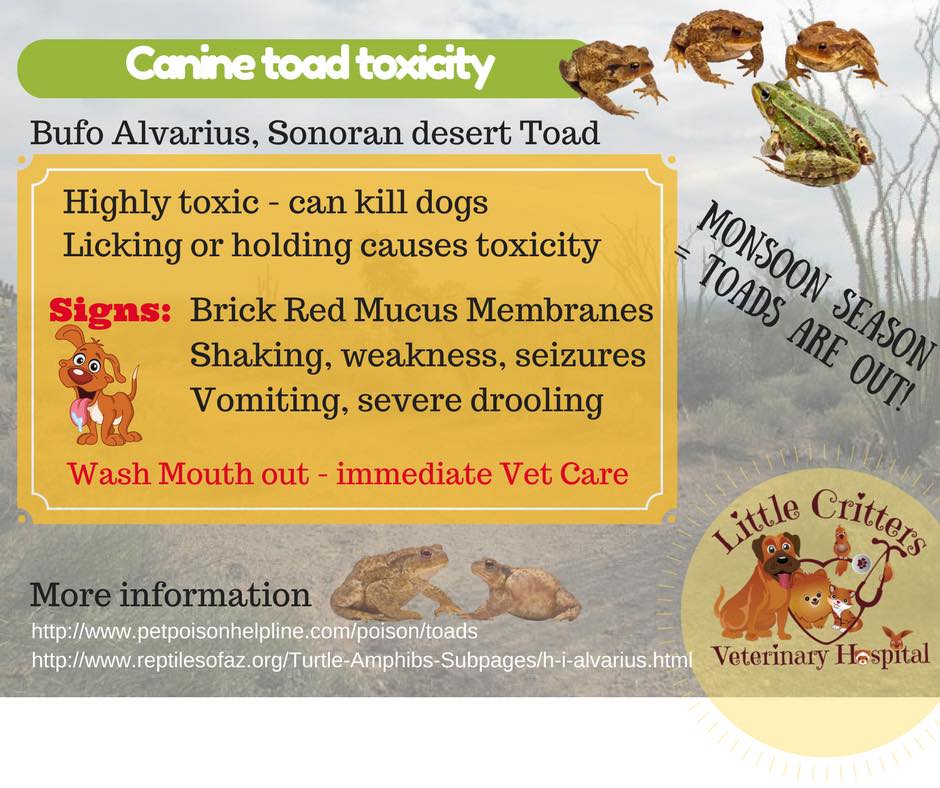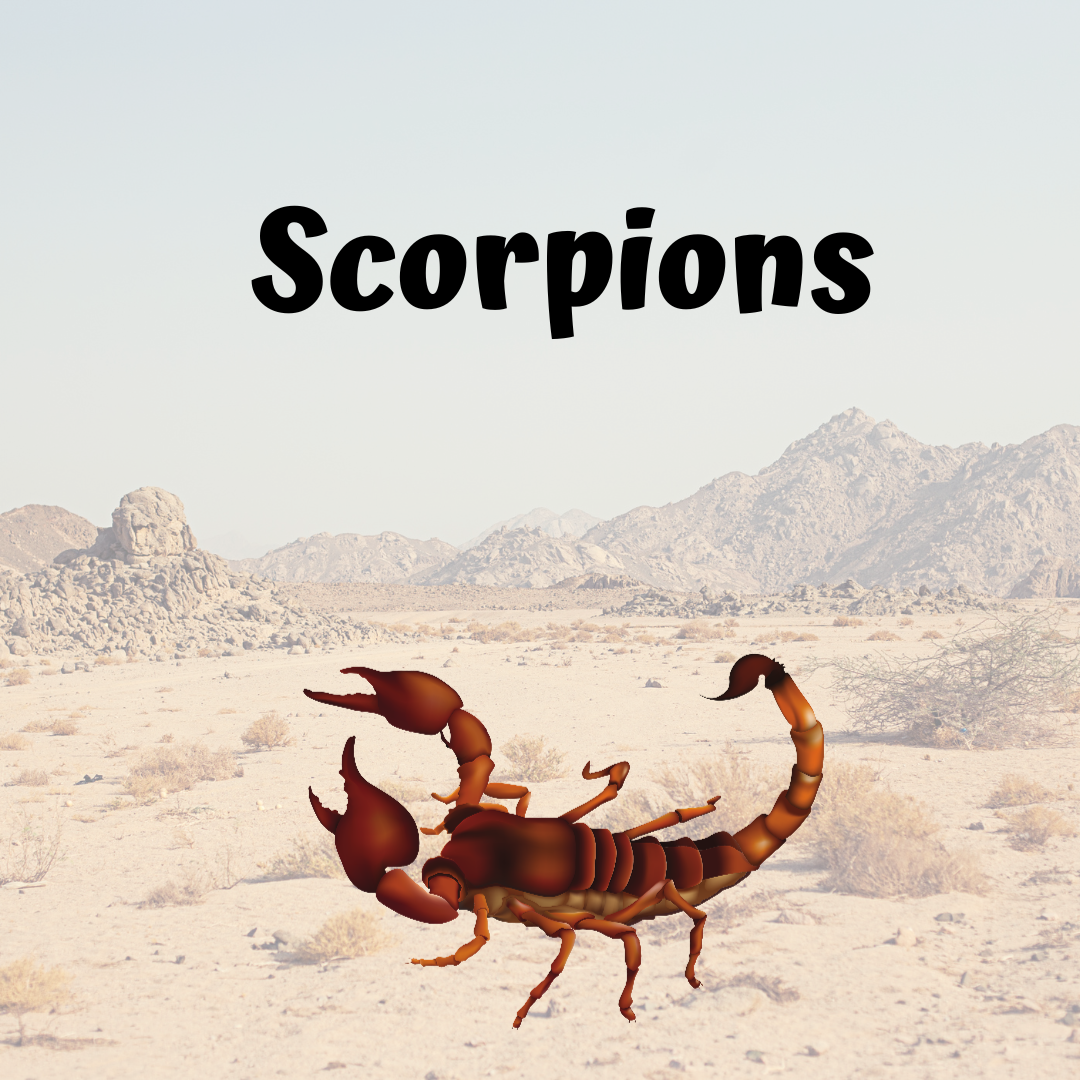|
The desert environment, while beautiful, harbors certain hazards for pets that owners should be mindful of to ensure their safety. Among these potential dangers are various creatures and plants, including scorpions, spiders (such as the brown recluse and black widow), Sonoran desert toads (bullfrogs), and even non-living threats like cacti. Rattlesnakes and various insects, including bees, also pose risks. Being aware of these potential dangers can help pet owners take preventive measures to protect their furry companions during their desert adventures.
BULLFROGS ( Bufo alvarius & Bufo marinus) – actually a toad.

In the Valley region, particularly after heavy rainfall, Sonoran desert toads, often referred to as bullfrogs, emerge at night. These nocturnal amphibians secrete a potent toxin from their salivary glands, which coats their skin and poses a danger to mammals. Dogs, out of curiosity or playfulness, may mouth or lick these toads, unknowingly ingesting the toxin. This exposure can cause serious health issues, characterized by symptoms such as bright red mucous membranes, excessive drooling, and neurological disturbances including disorientation, tremors, or even seizures.
Immediate action is crucial if a dog has interacted with a Sonoran desert toad. Rinsing the dog's mouth with water to remove any residual toxin should be the first step, followed by prompt veterinary attention. Veterinary care typically focuses on stabilizing the dog, which may involve treating seizures or tremors, providing intravenous fluids to counter shock or fever, and offering cardiac support to mitigate any heart-related complications from the toxin.
Awareness and prevention are key, especially during and after rainfall in areas where these toads are known to inhabit. Pet owners are advised to supervise their dogs during outdoor activities, particularly at night, to prevent such potentially hazardous encounters.
Toads from Pet Poison Helpline
SCORPIONS

Scorpion stings, which can affect both humans and animals, typically result in local swelling and pain. These creatures are common in desert areas, often found concentrated in certain locations. Scorpions tend to hide under ground debris during the day and emerge at night to hunt insects. While completely eliminating them can be challenging, local exterminators are usually the most effective solution. Regularly spraying both indoors and outdoors helps control insect populations, which in turn can reduce the presence of their predators, including scorpions. Scorpion stings, which can affect both humans and animals, typically result in local swelling and pain. These creatures are common in desert areas, often found concentrated in certain locations. Scorpions tend to hide under ground debris during the day and emerge at night to hunt insects. While completely eliminating them can be challenging, local exterminators are usually the most effective solution. Regularly spraying both indoors and outdoors helps control insect populations, which in turn can reduce the presence of their predators, including scorpions.
Scorpions Pet Poison Helpline
SNAKE BITES

In the Valley, snake bites can be a concern, varying by location and season. In the N.E. valley, we occasionally encounter dogs bitten by snakes, often due to curiosity or provocation. Not every snake bite leads to envenomation, and the severity of envenomations varies. It's crucial for any pet suspected of a snake bite to be examined by a veterinarian. The use of human antivenin in dogs is a topic of debate in veterinary medicine, with some pets experiencing severe allergic reactions to it. Meanwhile, many bitten pets recover without it. Prompt veterinary examination is key in managing snake bites, as predicting outcomes is difficult. For those frequently hiking with dogs in snake-prone areas, snake avoidance classes are recommended. Additionally, there's a Rattlesnake Vaccine available, but it's not foolproof, and bitten pets may still require antivenin therapy. Links for snake avoidance classes, snake removal services, and Arizona snake identification can be helpful resources.
Link to snakes of Arizona – http://www.reptilesofaz.org/snakes.html
Pet Poison Helpline for More information
Rattle Snakes
Coral Snakes
Snake Training: https://www.rattlesnakeready.com/
Vaccine
SPIDERS

In our region, the two primary problem spiders are the brown recluse (Loxosceles) and the black widow spider (Latrodectus), with the latter depicted in the left panel of our resource. Both species pose significant health risks to dogs and cats. Bites from the brown recluse can lead to severe local tissue damage, characterized by necrosis, whereas black widow bites are known for causing acute pain and neurological symptoms, including muscle weakness and paralysis.
Prompt supportive care, which includes supporting bodily functions and treating or preventing shock, is vital following such spider bites and should be administered by a veterinarian as soon as possible.
In contrast, tarantulas, although intimidating in appearance, pose minimal risk to humans and pets. They are generally non-aggressive, resorting to defense only when threatened. One of their defensive mechanisms includes flicking irritant hairs, similar to small cactus spines, from their abdomen. It's advisable to leave tarantulas undisturbed if encountered, as they are unlikely to attack without provocation.
Arizona Spider ID
Black Widow Spiders
About Brown Recluse Spiders
LIZARDS

Lizards, generally, are low-risk animals and are best left undisturbed in their natural habitat. The Gila Monster, notable as the only potentially dangerous lizard in some regions, is not aggressive by nature and typically does not attack unless provoked.
In the rare instance that a pet is bitten by a lizard such as a Gila Monster, the animal might experience symptoms like pain, swelling, and potential infection at the site of the bite. In such cases, it's important to seek veterinary care promptly. Treatment may involve administering medications to manage pain and inflammation, and antibiotics may be prescribed to prevent or treat infections. It's always prudent for pet owners to monitor their pets when outdoors, especially in areas where potentially harmful wildlife is known to reside, to avoid such encounters.
About Gila Monsters
AZ Poison Info
CENTIPEDES & MILLIPEDES

Centipedes, while they might appear intimidating, are another low-risk creature in Arizona and are not commonly associated with significant pet health issues.
While a centipede bite can be painful for pets due to the venom they inject, these incidents are generally of low risk in terms of causing serious health problems. The primary concerns following a centipede bite usually involve temporary pain and possible swelling at the bite site. In most cases, these symptoms are mild and can be managed at home. However, if a pet appears to be in considerable discomfort or shows signs of an allergic reaction, it is advisable to seek veterinary care. As with other wildlife, it's best for pet owners to keep an eye on their pets outdoors to prevent encounters with centipedes and other creatures.
Centipede bites
TARANTULAS

Tarantulas, despite their daunting appearance, pose very little risk to pets. These arachnids are generally non-aggressive and only react defensively when provoked. One of their defense mechanisms is flicking urticating hairs from their abdomen. These hairs can cause irritation if they come into contact with sensitive areas such as a pet's eyes or nose. The irritation is usually mild, but if your pet shows signs of discomfort or distress after an encounter with a tarantula, such as excessive scratching, rubbing, or redness in the affected area, it's advisable to consult a veterinarian. As a precaution, it's best to supervise pets and prevent them from disturbing these creatures.
Fact Sheet
For more information visit this link: https://www.petpoisonhelpline.com/uncategorized/venomous-creatures-poisonous-to-pets-in-north-america/
|